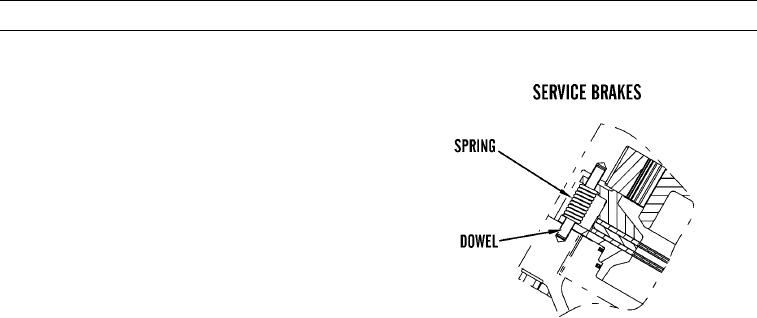
TM 5-3805-291-23-1
THEORY OF OPERATION - CONTINUED
0003 00
BRAKE AND HYDRAULIC FAN SYSTEM - CONTINUED
(1)
All four service brakes are located in
axle assemblies. Service brakes are actu-
ated by either left or right brake pedal.
Service brakes are in both front and rear
axles.
(2)
Each service brake consists of a piston,
two friction discs, two reaction plates,
three dowels, and three springs.
427-C1773
(3)
Reaction plates and piston are held stationary by dowels. Dowels are fastened in differential housing and
axle shaft housing. Piston and reaction plates are able to slide on three dowels, but piston and reaction
plates do not rotate. Springs keep piston in RETRACTED position so long as oil behind piston is not pres-
surized.
(4)
Friction discs have splines on inside diameter that fit on splines of sun gear. This causes friction discs to
rotate at a speed equal to that of sun gear. Grooves are cut into faces of friction discs to allow passage of
cooling oil between reaction plates and friction discs, and between piston and friction discs.
(5)
Coolant passage will occur even when service brakes are applied. If groove depths in friction discs are
within specifications, cooling oil will constantly flow between friction discs, reaction plates, and piston as
friction discs rotate.
(6)
Carrier is fastened with splines to axle shaft. Axle shaft turns with carrier. Planetary gears in carrier rotate
between sun gear and stationary ring gear.
(7)
When an operator depresses a brake pedal, pressurized oil from service brake control valve flows through
an oil passage in differential housing. Force of oil behind piston moves piston against force of springs.
(8)
Force of oil also pushes friction discs against reaction plates. This causes friction between friction discs
and piston, and between friction discs and reaction plates. This friction causes sun gear, axle shaft, carrier,
and wheels to stop.
(9)
Heat created by friction of service brakes is removed by oil in axle housings.
0003 00-98

